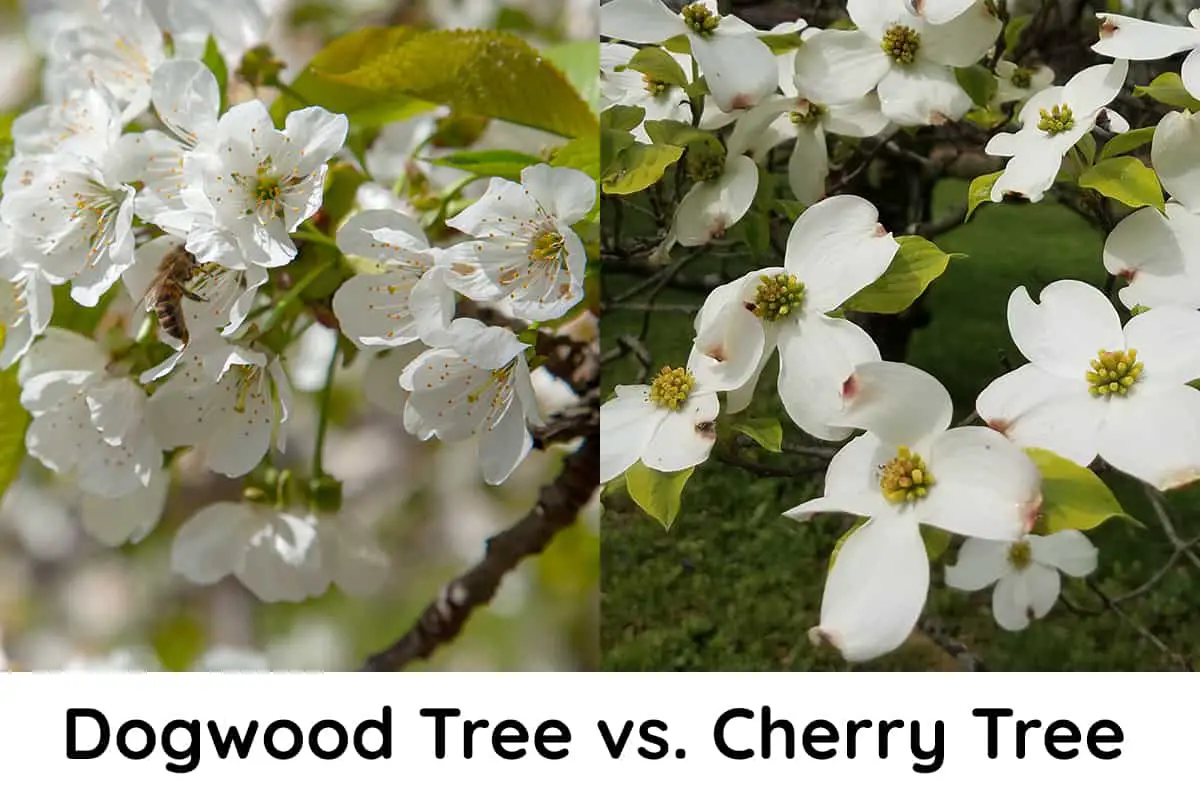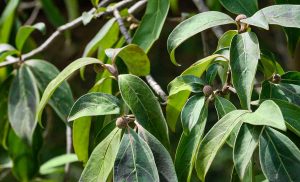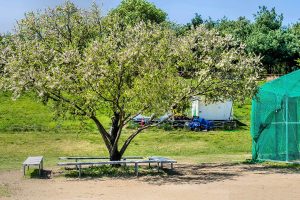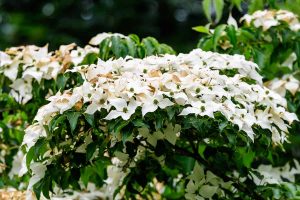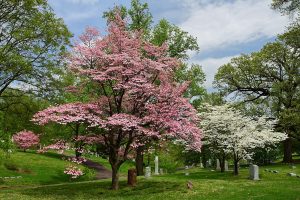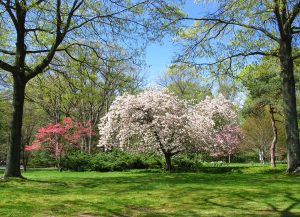Dogwood trees (Cornus sp.) and cherry trees (Prunus sp.) are similar in the way that they are both flowering deciduous trees, and they both produce white and pink blooms. They also have some similarities in terms of their care requirements, but there are some significant differences.
Here we look at what differentiates the dogwood tree from the cherry tree, helping you to identify one tree from another, and giving you an understanding of which tree might work best for your own climate and circumstances.
Table of Contents
Dogwood Tree and Cherry Tree Physical Differences
There are a number of different physical or visual differences between these two types of flowering trees, which can be used to identify the cherry tree from the dogwood tree.
Size
Dogwood trees are significantly smaller than cherry trees at maturity. Though different varieties of these trees come in different ultimate expected heights, you will rarely find a dogwood tree taller than 30 feet, whereas cherry trees more typically reach around 50 feet in height.
Dogwood trees, in their natural environment, are understory trees, and therefore they have a smaller stature than cherry trees, which do not grow beneath the canopy of taller trees. If you are looking for a tree to provide shade, then either the dogwood or the cherry tree can work well since they both have broad, full canopies. However, if you are looking for a tall tree to add height to your landscape, then the cherry blossom tree would be a better option.
Shape
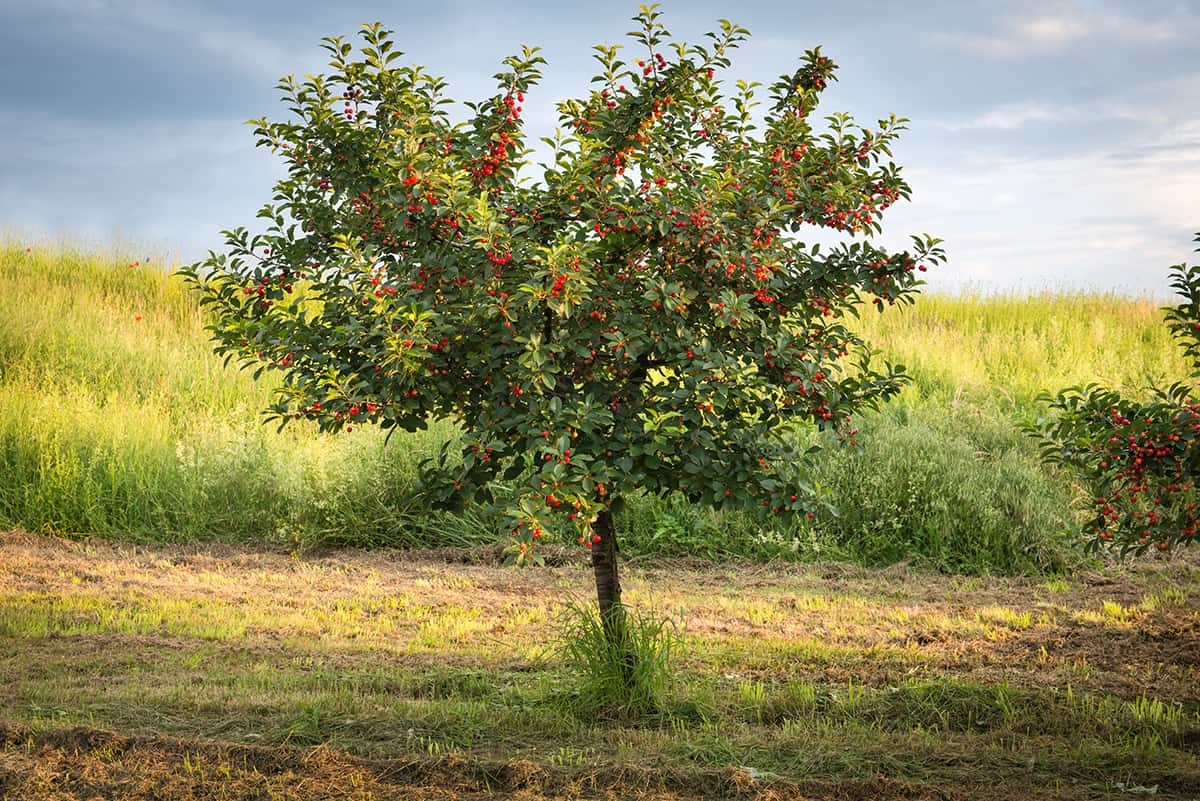
The dogwood tree canopy typically takes a rounded shape with a flattened top, while the cherry tree has a more vase-like shape. The dogwood tree can often be seen with low-hanging branches, while the cherry tree branches are more spreading and far-reaching. If you look closely at the way the branches grow on a dogwood tree, you’ll notice that they have an opposite branching pattern.
The cherry tree does not, and instead, has an alternate branching pattern. If you are trying to ascertain whether a tree is a cherry tree or dogwood tree during winter when there are no leaves or flowers on the tree, then taking note of the branching pattern is the best way to correctly identify the species.
Flowers
Both dogwood trees and cherry trees produce pink and white flowers, though the majority of dogwood trees have white flowers. In scientific terms, these flowers are very different. On a cherry tree, the flowers are ‘true’. This means the white or pink petals are real petals that surround the anthers of the flower.
On a dogwood tree, however, the pink and white blooms which we commonly refer to as flowers are in fact not flowers at all. Instead, they are bracts, and the real flowers can be seen in compact clusters in the middle of the bracts. From a visual perspective, it may not be easy to tell the difference between a dogwood flower and a cherry tree flower from a distance. However, if you can get up close to the flowers, you will note that a dogwood flower typically has four petals, while a cherry tree flower will have at least five.
On pink flowering dogwoods, the petals are usually clipped at the end to give them an unusual shape, while the petals of the cherry tree flowers are perfectly rounded. Some cherry tree flowers will have a ruffled shape, which is not seen on dogwood flowers.
The blooming time of both the cherry tree and dogwood tree are similar, with both trees typically flowering in spring on bare branches before the emergence of foliage. If you see a tree blooming in late June, then this can be identified as the Kousa Dogwood (Cornus kousa), which flowers later than the majority of other dogwood species.
Foliage
The foliage of the dogwood tree is quite different from the cherry tree, and this may be one of the easiest ways to differentiate these species from each other. The leaves on a dogwood tree can be medium green or dark green depending on the type of dogwood, and in some cases, they can even be variegated.
However, the shape of the leaf is consistently ovate, coming to a point at the end. Most importantly, dogwood tree leaves have smooth edges. Cherry tree leaves are dark green, and they have finely serrated edges. The way foliage emerges on a tree is also different on a dogwood tree compared to a typical flowering cherry tree. The leaves on a dogwood branch will emerge opposite each other, seemingly growing out of the same point on the branch. By comparison, the leaves on a cherry tree branch will be arranged alternately.
Bark
The bark of a cherry tree is smooth and tan in color, with some horizontal markings around the trunk. The bark of a young dogwood tree can look similar since it is smooth and pale when not yet mature, in shades of gray or tan.
However, as a dogwood tree ages, it takes on a more textured bark, and the color will deepen to dark gray. In some species, the bark of a dogwood tree will exfoliate or take on an alligator skin pattern; neither of these can be seen on a cherry tree and can therefore be considered as distinguishing attributes.
Dogwood Tree and Cherry Tree Care Differences

The different care requirements of these two flowering trees are important to understand since they may make one type of tree better suited to growing in your local region.
Light
Dogwood trees can grow in full sun, partial shade, or almost complete shade. However, they prefer a partially shaded position. They are understory trees in their natural environment, growing beneath the dappled shade of taller trees.
By comparison, cherry trees require full sun in order to bloom. If you are looking for a flowering tree to occupy a semi-shaded spot in your landscape, then the dogwood tree will be the best option since a cherry tree won’t perform well in these lighting conditions.
Soil
Cherry trees and dogwood trees enjoy similar soil types. They both like to be grown in well-draining soil, which is moisture retentive and kept moist but not wet. Both trees also prefer soils that are either neutral or acidic, and do not perform well in alkaline soil. Dogwood trees and cherry trees will thrive in fertile soils rich in organic content.
Some dogwood trees, such as the Swamp Dogwood, like to be grown in wet soils, but this is the exception rather than the rule. Most dogwood trees, like most cherry trees, should not be kept in soils that are either soggy or excessively dry.
Temperature
Cherry trees and dogwood trees are suitable for growing in similar climates, though the cherry tree tends to be slightly hardier than the dogwood tree. Cherry trees are recommended for growing in USDA hardiness zones 4 to 8, and dogwood trees are recommended for growing in USDA hardiness zones 5 to 9.
If you live in a warmer climate, then choose a dogwood tree over a cherry tree, as these are better at coping with higher temperatures. For those in cooler climates, the cherry tree will be more suitable for surviving through cold snaps.
